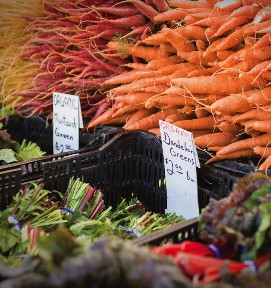
Remember your mother telling you to eat carrots for good eyesight? She was right. Today we’ve learned that not only carrots, but also a host of other vegetables, fish, nuts, and fruits can affect your eye health. Indeed, not just the foods, but also their pairing combinations—tomatoes with olive oil, avocados with pink grapefruit—can have a positive impact. If you are among the ten million Americans with age-related macular degeneration, which may cause 1 out of 4 baby boomers to lose their central vision eventually, eating the right foods may be not only a good idea but also critical to your health.
So, eat your antioxidants. But where does one find flavorful recipes with ingredients customized to benefit your eyes? We can’t live on carrot soup. Health cookbooks on the market tend to be uninspired, with recipes that are often dull and bland. Beautiful lifestyle cookbooks—the ones we savor and pore over—often have enough salt and fat to give you high blood pressure. What’s been missing is a savory cookbook that’s fun to read (easy on the eyes) while also highlighting ingredients that promote eye well-being. Assembled here for the first time is a cookbook that guides you along the road to good eye health while offering original recipes that taste great too.

It can be hard work figuring out what foods are best for your health and then finding a way to cook them interestingly week after week. For years, I’d rely on a few staples and just eat sensibly, hoping I got everything I needed. We all know that oranges are a great source of vitamin C and contain an impressive amount of essential nutrients, vitamins, and minerals; many people drink orange juice daily as a result. But who would think to eat sardines, which not only are a power food in staving off macular degeneration, but also pack a nutritional wallop with high omega-3 fatty acids and protein that helps lower blood pressure, reduces the risk of heart attack, and is an important anti-inflammatory agent (essential for healthy skin, hair, and nails)? Moreover, how do you prepare sardines, other than serving them on crackers with mustard? People are busy, and life gets in the way of researching nutritional goals and how to achieve them through diet. This book spells out what you need for healthy eating and dishes up flavor and variety. (One simple hint: eat yellow, red, and green fruits or vegetables every day.)
Our instinct to eat certain foods to promote eye health is not new; in the sixteenth century, Spanish explorers took chile peppers, which are rich in beta-carotene, vitamins C, E, B6, and folic acid, on sea voyages to promote night vision. Ancient Greek philosophers wrote about the medical benefits of olive oil. In the 1920s, the nutritionist Victor Lindlahr (who, as Dr. Seddon notes, was an early believer in the idea that food determines health) developed the Catabolic Diet. That view gained some adherents at the time, with the earliest recorded support coming from an ad in the Bridgeport Telegraph in 1923:
Ninety per cent of the diseases known to man are caused by cheap foodstuffs. You are what you eat.
With this cookbook, we take his advice to heart. Indeed, our hearts, bodies, and eyes depend on it.
Jennifer Trainer Thompson